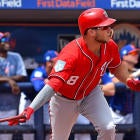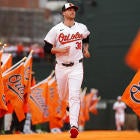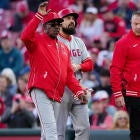With the regular season concluding, we've decided to take a look at each team's future -- not by using a crystal ball or other psychic abilities, but by evaluating their farm systems. Below you'll find our ranking of the top five prospects in the organization -- sorted by perceived future potential -- as well as five other players who fit various categories. Those categories are:
2020 contributor: A player who is likely to play a role for the big-league team next season.
Analyst's pick: A player who is a strong statistical performer and/or whose underlying measures are better than the scouting reports suggest.
Riser: A player on the way up.
Faller: A player on the way down.
One to watch: An interesting player to keep in mind (for whatever reason).
These rankings were compiled after talking with various industry sources about the systems (and players) in question. It should be acknowledged that this process is more art than science, and that there are limits to ordinal rankings. Still, it's an intuitive system, and our hope is that the write-ups will answer any questions by providing additional context and analysis of each player -- such as their pluses and minuses; the risk factors involved; and their estimated arrival date.
One last word on eligibility: we're following MLB's rookie guidelines by disqualifying any player with more than 130 big-league at-bats or 50 innings pitched.
Well, at least the Nationals are World Series champions -- that's the point of the game, not having a ton of prospects.
1. Carter Kieboom, 2B/SS
The only player in the Nationals' top five to reach the majors in 2019, Carter Kieboom had a forgettable 11-game stint early in the spring during which he nearly recorded twice more strikeouts (16) than times on base (nine). Woof.
The good news for Kieboom is multifaceted. It was just 11 games, after all, and he fared well in Triple-A, where he hit .303/.409/.493 with 16 home runs and a healthier strikeout rate. Tools-wise, Kieboom still profiles as a potential regular thanks to his bat and strong throwing arm, both of which grade as at least above-average, if not better.
Even with the strong arm, Kieboom is not likely to remain at shortstop for much longer -- Washington had him play a lot of second base in the minors this season, and that seems like his likeliest landing spot.
Presuming Kieboom fares better heading forward, he could check in as a two-way contributor at the keystone as soon as next season.
2. Luis Garcia, SS
Statistically, Luis Garcia had a poor season, hitting just .257/.280/.337 with five times as many strikeouts as walks in Double-A. Yet it's hard to hold those marks against him, seeing as how he won't turn 20 until next May.
That's right, Garcia spent most of the season as a 19-year-old, playing against competition that was -- on average -- about five years his senior. There are aggressive assignments, and then there are aggressive assignments. This was the latter.
Physically, there's still plenty to like about Garcia, who could develop four average or better tools in due time (everything except power). He does need to improve his approach if his hit tool is going to play, but that's to be expected: He's a teen.
The Nationals will presumably permit Garcia to repeat Double-A to begin the 2020 season.
3. Wil Crowe, RHP
Wil Crowe is a physical right-hander with a deep, if mostly average arsenal who should make an appearance or five in the majors before this time next year.
Crowe split the season between Double- and Triple-A, struggling after his promotion to the extent that it's worth wondering how much the altered baseball came into play. It is worth noting that Crowe experienced some growing pains during his initial run at Double-A, too, so perhaps this is just part of the transition process for him.
Crowe has dealt with various medical issues in the past, including Tommy John surgery, which wiped out an entire collegiate season. The Nationals have a loaded rotation, but a healthy Crowe should find his way into the Show in a spot-starter capacity in 2020.
4. Mason Denaburg, RHP
The 27th pick in the 2018 draft, Mason Denaburg is another slow-burn candidate whose stock ticked up after an impressive instructional league debut last fall.
Denaburg has the frame and the makings of an arsenal -- particularly his fastball and breaking ball -- that could lend itself to a fruitful career as a mid-rotation starter. But he just turned 20 years old, and the Nationals are wisely taking their time to develop him after he missed time the previous spring due to a biceps issue.
Denaburg threw only 20 innings in 2019, and while the results weren't particularly impressive, it's also 20 innings. Denaburg should pitch more -- and better -- in 2020.
5. Seth Romero, LHP
This is a potentially stupid ranking.
Seth Romero has always had the talent to be a quality big-league pitcher. But he's also always had some self-constructed hurdle standing in his way -- be it a fight with a teammate that resulted in him being kicked off the team at the University of Houston, or other incidents that have cost him supporters and repetitions.
Romero's latest setback isn't necessarily his fault: his UCL popped, requiring Tommy John surgery that wiped out his 2019 season. Yet the time off could prove beneficial. Early reports suggested the rehab process -- grueling in nature -- may have helped Romero mature and gain perspective on what he's been taking for granted.
It's possible Romero steps in it again over the next few months, rendering all the renewed good will moot. But if he has achieved enlightenment, then he may eventually become a valuable big-league starter.
2020 contributor: James Bourque, RHP
Right-handed reliever James Bourque has already pitched in the majors, having faced six batters in his May debut. He has the potential for two quality offerings, including a mid-to-upper 90s fastball, but there is some reason for reservation. Foremost, he has below-average command. On top of that, it's perhaps not a great sign that the Nationals didn't ask him to make more appearances over the remainder of the season, given the state of their bullpen. He'll presumably get more of an opportunity in 2020.
Analyst's pick: Cole Freeman, INF
A senior draftee out of LSU, Cole Freeman hit .311/.394/.404 with 31 steals (on 37 attempts) and nearly as many walks as strikeouts in High-A. The catch is that Freeman was old for the league (he's already 25). His physical tools are also unbefitting of a prospect -- he's listed at just 5-foot-9 and while he runs well he doesn't have a strong arm or much power to brag about. There's an outside chance he reaches the majors in a utility capacity. It seems more likely he enjoys a fine career as a depth piece who later coaches or scouts.
Riser: Tim Cate, LHP
Tim Cate recorded a career-best 143 innings in 2019, which was notable for a variety of reasons, beginning with the fact that it was the first time he'd ever topped 100 innings. Cate has had past injury woes, including Tommy John surgery in high school and subsequent forearm issues, and is on the smaller side so far as starting prospects go. But he throws strikes with an average fastball and has a nasty breaking ball that is his top pitch. His future role rides on whether he's able to string together a few more healthy seasons.
Faller: Gage Canning, OF
The top concern with Gage Canning, the Nationals' fifth-round pick in 2018, is that he has too much swing-and-miss in his game to maximize his quality speed and solid power potential. That criticism helps to explain his 2019, as he finished as a below-average hitter despite being in High-A, an age-appropriate level. Canning figures to give it another try.
One to watch: Jackson Rutledge, RHP
The 17th pick in the draft, Jackson Rutledge has a huge frame and big-time arm strength. The early reports on him weren't as promising as his quality numbers (in a small sample in A-ball) suggest, however, and he has a long way to go command-wise. Check back after his first full season to see if professional instruction can help him land in the Nationals' top five.






















